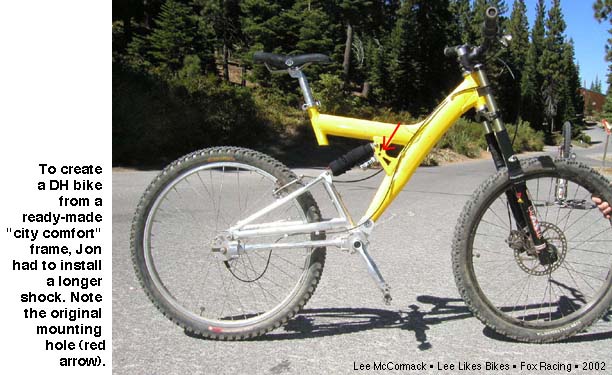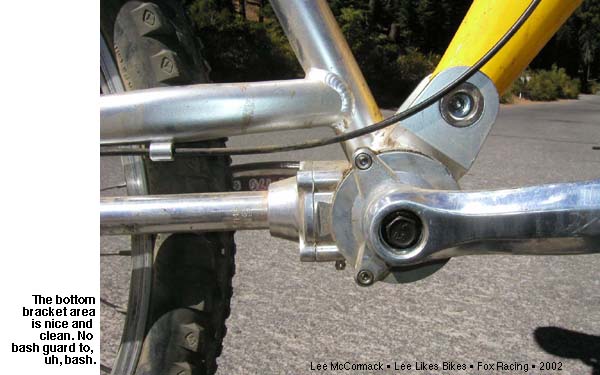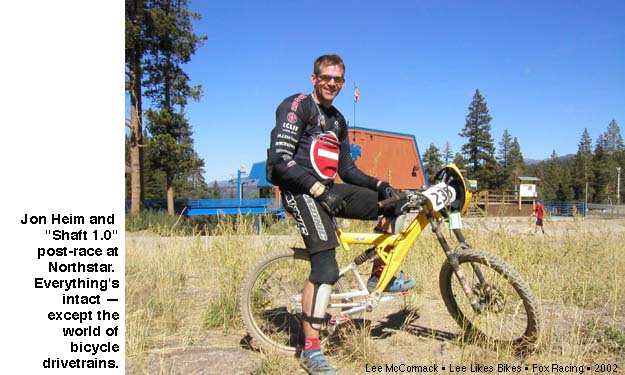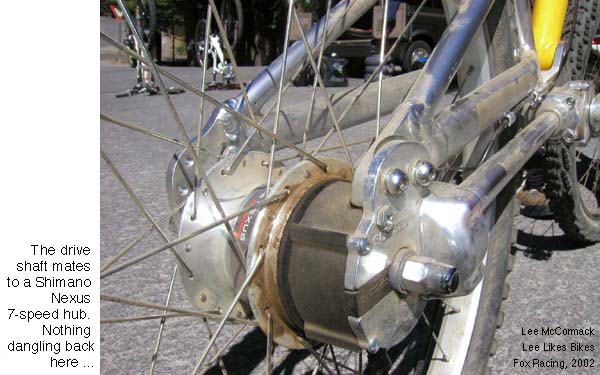Posted Oct. 25, 2004
The Shaft
This story originally appeared in Fall 2002 on the Fox Racing website and newsletter. The Shaft project is on the back burner, but it brings up a real issue for downhillers, an issue that companies like Honda and Nicolai are currently addressing.
At a Northstar at Tahoe DH race a couple weeks ago, my crazy-scientist friend Jon Heim unveiled his latest project, a shaft-driven DH bike!
 I met Jon through his HEIM 3Guide, a chain retention device for triple chainrings. I'd been craving something like this for months and when I heard about it at the Sea Otter, I jumped all over it. Since then I've been riding with Jon and getting the scoop on his various innovations. Jon is an engineer at the Stanford Research Institute. In addition to designing bike stuff like the WTB Stealth pedal, he's also worked on turbochargers, artificial muscle and magnetic levitation. So, I guess you could say he's a smart fellow.
I met Jon through his HEIM 3Guide, a chain retention device for triple chainrings. I'd been craving something like this for months and when I heard about it at the Sea Otter, I jumped all over it. Since then I've been riding with Jon and getting the scoop on his various innovations. Jon is an engineer at the Stanford Research Institute. In addition to designing bike stuff like the WTB Stealth pedal, he's also worked on turbochargers, artificial muscle and magnetic levitation. So, I guess you could say he's a smart fellow.
The rocks at Northstar wreak havoc on drivet rains. They smash chainrings, bend derailleur hangers and rip derailleurs to shreds. It's funny, in this age of burly bikes and body armor, that we still let our most sensitive parts dangle in harm's way. The last time Jon raced at Northstar, he was having a good run, then whammo! His derailleur left his frame. When he finally clattered over the line he swore "no more derailleurs." When I met Jon this spring, he was focused on retaining chains; now he is obsessed with obliterating them.
For his first prototype, Jon started with a shaft-driven "comfort city bike" made in Taiwan. The shaft drives a Shimano Nexus internal 7-speed hub. Jon DH'ed the rig out with a Boxxer, burly wheels and a longer shock. The result: a bike with 5 1/2 inches of rear travel, a 42x13-32 gear range, tons of ground clearance and no dangly bits.
The shaft drive definitely feels different than a standard chain drive. For one thing, there is some lost power. Jon says this attribute makes the shaft pretty much DH specific. You figure on a really gnarly course, clearance and bombproofness are way more important than pedaling efficiency. Heck, you could win on Northstar's Dog Bone course with only a few pedal strokes.
 Here's a cool thing about internal hubs: with a derailleur, you must be pedaling for the shift to happen. With an internal hub, you can shift while you're coasting or stopped. This has huge implications for racing: just blast into a turn, slam the shifter a few notches, then hammer out. No soft pedaling into the turn while you shift.
Here's a cool thing about internal hubs: with a derailleur, you must be pedaling for the shift to happen. With an internal hub, you can shift while you're coasting or stopped. This has huge implications for racing: just blast into a turn, slam the shifter a few notches, then hammer out. No soft pedaling into the turn while you shift.
 Shaft 1.0 has a unified rear triangle. A URT places the entire drive train on the swing arm, which keeps the cranks, shaft and hub joined nicely. Jon originally planned a four-bar shaft bike, but that would have required a spline drive like on a car, which would be heavier and more expensive. So, at this early stage, the Shaft has a URT. (Unlike the Trek Y-bikes, the Shaft's bottom bracket is close to the pivot, and suspension works fine when standing.)
Shaft 1.0 has a unified rear triangle. A URT places the entire drive train on the swing arm, which keeps the cranks, shaft and hub joined nicely. Jon originally planned a four-bar shaft bike, but that would have required a spline drive like on a car, which would be heavier and more expensive. So, at this early stage, the Shaft has a URT. (Unlike the Trek Y-bikes, the Shaft's bottom bracket is close to the pivot, and suspension works fine when standing.)
Jon hammered a half-dozen runs on the Dog Bone course and the Shaft held together. That's saying something. By all accounts, Dog Bone is gnarlier than any of the Norba National courses. You know the scary rock section at Mount Snow? The Dog Bone course is like that the whole way down.
 I watched Jon tackle the infamous Waterfall on the Karpiel Trail: super steep, with jagged rocks all the way down. I can't get down that thing without my MRP bashing so hard my feet come out of the pedals. With his super-high ground clearance Jon just charged on down, nice and clean. He looked like the world's smartest projectile.
I watched Jon tackle the infamous Waterfall on the Karpiel Trail: super steep, with jagged rocks all the way down. I can't get down that thing without my MRP bashing so hard my feet come out of the pedals. With his super-high ground clearance Jon just charged on down, nice and clean. He looked like the world's smartest projectile.
This experience proved to Jon that a DH bike with a shaft drive and internal hub is a viable machine. The way he sees it, here are the potential benefits:
- Two to three inches increased ground clearance.
- No fragile derailleur flopping in the breeze waiting to get smashed and kill your race run.
- No bouncing chain to derail.
- More consistent shifting.
- No extra weight compared to a conventional DH drive train.
- No chain lube mess.
- Simpler design overall; fewer moving parts.
Of course, there are shortcomings too (otherwise everyone would be riding shaft bikes). In future versions of the Shaft, Jon plans to work his engineering Kung Fu on these areas:
- Make the bevel gear more efficient.
- Make the rear wheel easier to remove.
- Create a thumb shifter. (Shimano and Rohloff hubs both use twist shifters.)
- Make the outer housing lighter and stronger.
- Wider gear range for all-around riding. Work with a Rohloff 14-speed hub.
- Redesign frame for bigger tires, beefier head tube and disc brakes.
- More travel!
- Down the road, develop a non-URT suspension design.
It's time downhillers had an alternative to the old gears and chain. We'll see. This could change everything.
|
|
|
